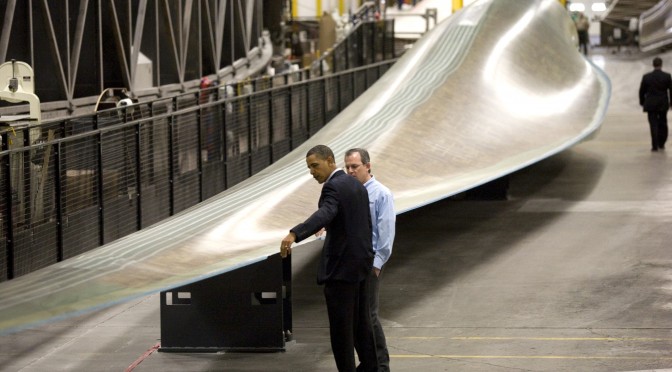Renewing the tax credit would add 54,000 jobs over the next four years, according to the American Wind Energy Association.
Wind power has emerged as one of the most clear-cut issues of the American political season. President Barack Obama wants to renew the technology’s soon-to-expire federal production tax credit. Mitt Romney, his Republican opponent, wants to let the credit lapse.
The best way to handle this is to find an option other than all or nothing. Yes, clean wind energy should receive continued federal support, as Obama says, especially at a time when the industry’s tens of thousands of jobs are helping the U.S. economy. But wind power should also be expected to make it in the marketplace on its own one day, as Romney would have it.
Onshore wind power has improved to the point where it is now the most competitive of all renewable energy sources except hydropower. According to recent estimates from Bloomberg New Energy Finance, it’s on a path to reach “grid parity”—the point where its cost is equal to the baseline price of power on the grid—by 2016. In the long run, in other words, wind can be expected to thrive without the tax credit.
A clear plan to phase out the credit over the coming four years could actually be a gift to the wind industry, which has suffered from the federal program’s unpredictability even as it has benefited from its support. The 2.2¢ tax credit, paid to wind-energy companies for every kilowatt-hour of power they produce, has brought the industry more than $1 billion a year, according to the Joint Committee on Taxation. Yet over the two decades it has existed, Congress has allowed the credit to expire three times, and each time progress in building wind capacity has fallen precipitously.
Renewing the tax credit would add 54,000 jobs over the next four years, according to the American Wind Energy Association, an industry group. Letting the credit expire, on the other hand, would mean losing 37,000 jobs in the sector. Wind power has a promising economic future as the cost per turbine continues to fall.
If Congress takes the easy route and simply extends the credits for a year or two, it would only perpetuate the wind industry’s boom-and-bust cycle. A smarter solution is to apply the longer-term planning that is critical to good energy policy. Let the wind industry know the production tax credit will eventually die out—but over four years so companies are able to plan their operations without the need to guess what tax support they will have.
Even smarter would be to ultimately replace the tax credit with market-based support for wind as well as other forms of clean energy. Many states now have so-called renewable portfolio standards, which require utilities to use a certain percentage of electricity generated by wind and other kinds of renewable power. These states set a target, in other words, and the market figures out the most efficient way to reach it.

